Bach, Busoni, Segovia, and the Chaconne
Note
I’m interrupting my “Thinking About Practice” series to update a post I rattled off in August 2009 on my Pristine Madness blog about the relationship between Andrés Segovia’s guitar “transcription” of J. S. Bach’s famous Chaconne from the Partita in d minor, BWV 1004, and Ferruccio Busoni’s more famous arrangement of it for solo piano. As I’ll be performing the piece in 2016, I figured I should update the post and move it over to my Guitar Whisperer Blog, which I’m reserving for musical topics only.
The "Modern Problem"
During my talk on “The Re-Imagination of Performance” at the 2009 Guitar Foundation of America’s International Convention and Competition at Ithaca College I tried to show that performers who came of age before the 1930s or 1940s exercised more freedom in their relationship to their scores than today’s performers do: these earlier performers inherited a tradition that saw no conflict between musical individuality and the realization of a composer’s “intentions.” Until the ubiquity of Urtext scores, there was no meaningful distinction between interpreting a piece of music and interpreting a composer’s intentions. These musicians, as Richard Taruskin has written about Pablo Casals, “did not have to face the ‘modern problem,’ so memorably defined by Auden, in his great essay on Yeats, as that of being ‘no longer supported by tradition without being aware of it.’”[1] Performers born in the late nineteenth century could simply exist in and excel in one style.[2]
Taruskin argues that the concept of historic authenticity in the performance of early music developed concurrently with modernism and shares its values. He writes in the essay “The Modern Sound of Early Music” in Text and Act, “historically-authentic performance,” “historically-aware,” “historically-informed,” or “historically-accurate,” whichever you wish to call it—each of these terms has been used at various times by those whom Taruskin calls the “Early Musickers”—is actually a modern construct that is “implicitly projected back into historical periods that never knew it.”[3] (Taruskin’s essay originally appeared in The New York Times under the title, “The Spin Doctors of Early Music” in July 1990.)
The terms don’t matter to me—Taruskin refers to them all as “ersatz shibboleths”—but I am interested in how “early music values” have affected our attitudes towards arrangements of baroque music made by musicians in the relatively recent past—say, ninety-to-a-hundred (or more) years ago—and the performance freedoms that accompanied these arrangements.[4]
Modern Constructs
What are these modern constructs that we might be projecting backward? Here are two of the characteristics of modernism in the performance of classical music as put forth by Taruskin in his book Text and Act:[5]
- It is text-centered, hence literalistic.
- It is impersonal, hence unfriendly to spontaneity.
Text-Centered
The text-centricity of early music can be seen in the proliferation of Urtext editions. I find these editions invaluable, yet often the sound of a modern, historically informed performance based upon them “presents the aural equivalent of an Urtext score: the notes and rests are presented with complete accuracy and an equally complete neutrality.”[6] This is both literal and impersonal, a privileging of standardization, virtuosity, accuracy, perfection, and patterns of conformity above experimentation, idiosyncrasy, interaction, individuation, and creative play.[7] And it is anathema to the modern performer to add notes to a historic score.
Clive Brown calls this “cult of the urtext”:
…too great a reliance on such ‘pure’ texts creates its own dangers. The publication of durchgesehene kritische Gesamtausgaben (revised critical complete editions) in the second half of the nineteenth century sowed the seeds of a tendency which has achieved its full flowering in the second half of the twentieth century. Despite the counter-currents of heavily edited ‘classics’ from Ferdinand David and Hugo Riemann in the nineteenth century to Carl Flesch, Arthur Schnabel, and many others in the twentieth century, the cult of the urtext [italics mine] has grown slowly but steadily until many modern musicians, including advocates of period performance, have invested these editions with a mysterious, almost sacrosanct quality, as if the more literally the notes, phrasings, dynamics, and so on, which constitute the composer’s latest ascertainable version of the work, are rendered, the closer the performance will be to the ideal imagined by the composer.[8]
As we’ll see, a prescient Ferruccio Busoni complained about the rise of literalism in performance over a hundred years ago.
Impersonal
Taruskin sums up the impersonalism of early music nicely:
The impersonalism of Early Music has resulted in performances of unprecedented formal clarity and precision. It has also resulted in a newly militant reluctance to make the subtle, constant adjustments of tempo and dynamics on which expressivity depends…[9]
Ferruccio Busoni (1866-1924) in his Sketch for a New Esthetic of Music[10] from 1911 thought that music notation was simply an expedient device to capture the composer’s inspiration for the purpose of releasing it later. But Busoni was concerned that the musical “lawgivers” (his term) were now requiring performers to reproduce the rigidity of the signs. The more closely they did so, complained Busoni, the closer performers were persuaded they could achieve perfection. Busoni maintained that performers were obligated to use their own inspiration to turn the rigid signs back into emotion and to make the work manifest. Busoni saw this as the essence of creativity in performance: “What the composer’s inspiration necessarily loses through notation, his interpreter should restore by his own.”[11] The performer’s inspiration (read: individuality) was a necessary catalyst for releasing the composer’s inspiration.
What Busoni saw before anyone else was the early stage of a shift from the work existing primarily as a performance to the work existing primarily as a written text: the notation was beginning to stand for musical art itself. And as the century progressed, so did the rise of literalism and impersonalism. Toscanini demanded that his musicians “play what was set before them exactly as written regardless of ‘tradition,’” and Stravinsky railed “against ‘interpretation,” and wanted his performers to be obedient ‘executants’ of his will.”[12] These positions typified a performance aesthetic that was gathering strength in the 1920s and 1930s and was the dominant performing style by the 1940s and 1950s.
Peter Kivy summed it up in 1998 when he wrote that “the driving force behind the historical performance movement is the desire to collapse performance into text.”[13]
A Cosmos In Itself
Carl Flesch, the great violin teacher, said of the Bach Chaconne: “Only a fool would maintain that the Chaconne, this cosmos in itself, could be visioned through a single prism.”[14] Since its publication by Simrock in 1802, the work has been refracted through innumerable prisms:
Mendelssohn (1847) and Schumann (1854) each wrote accompaniments to the violin part, turning it into a duet; pianists Joseph Raff (1822–1882) and Ernst Pauer (1826–1905) each published versions for solo piano in 1867 (Pauer adds a cadenza before the final eight bars); Brahms made a piano version for left hand alone in 1879; and Busoni’s arrangement was first published in 1897 in Leipzig. There have been other arrangements for piano, orchestra, orchestral accompaniment to the solo violin, piano four-hands, two pianos, string quartet, string quartet with piano, and solo guitar.
Franz Liszt mentions the piece several times in his letters and on February 8, 1884, wrote to Otto Lessman: “On a previous occasion I also heard at Meiningen Bach’s celebrated Chaconne played in unison with a real virtuosity by some ten violins.”[15]
Can the light refracted by these Romantic prisms reveal anything to us? Can a Romantic approach to Bach ever gain historic legitimacy of its own? If so, when? When I was a student early recordings were simply old-fashioned; now they’re studied as historic documents. What’s changed, other than the passage of time? Can something similar happen to these capacious prisms, or are they forever to be the eight-track tapes and betamaxes of music history?
Guitarists and the Bach Chaconne
Many of today’s concert guitarists prefer to play the Chaconne directly from the violin score, and the piece works fine that way, but Andrés Segovia (1893-1987) didn't simply transcribe the violin score. He transcribed something in the 1920s, published it in 1934, performed it in Paris in June of 1935, and recorded it in 1955, but it wasn’t based exclusively upon Bach’s violin score. Segovia “transcribed” parts of Ferruccio Busoni’s arrangement of the Chaconne, an arrangement made in 1891-1892 while Busoni was living in Boston, and premiered by him in that city in 1893. In addition to the Leipzig publication of 1897, Busoni published new editions of it in 1902, 1907, and 1916, continually refining his ideas.
What Segovia transcribed is important, because although many amateur guitarists once perceived Segovia’s transcription as the sine non qua of the guitar repertoire, most professional concert artists reject it for its failure to meet modern criteria for Baroque performance practice and find all the added notes at odds with an “Urtext aesthetic.”
Segovia’s usual transcription process was to eliminate notes (and sometimes change them) to get a piece to work on the guitar, especially when transcribing keyboard music. In his Bach transcriptions of music for solo ‘cello or violin, e.g., the courante from BWV 1009 or the bourée from BWV 1002, he would add bass notes and fill in harmonies, but he never added material to the extent he did in his edition of the Chaconne.[16]
Although Segovia considered his version of the Chaconne a “transcription” (it says so right on the music), every piece that Segovia played on the guitar that was originally composed for another instrument, was labeled by him a “transcription.” Busoni used the word “Bearbeitung” (to edit or adapt) for his version, as opposed “Übertragung” (to carry over or transcribe) on his score: his version was clearly an arrangement, and according to Busoni, a necessary one:
I start from the impression that Bach’s conception of the work goes far beyond the limits and means of the violin, so that the instrument he specifies for performances is not adequate for its realization.[17]
Historic or simply old-fashioned?
It’s one thing to reject something on the grounds that it lacks “historic authenticity,” or, more correctly, fails to meet a modern criterion, a criterion that had yet to develop when Busoni made his arrangement, and betrays the modernist disdain for adding notes and expression markings where there were none in the original; and it’s quite another to reject a Romantic tour de force. Busoni’s dynamic and atmospheric transcription made no claim to historic authenticity, so why should we ascribe such a claim to Segovia’s arrangement, which was based upon Busoni’s work? If we accept there is no claim to historic authenticity in Segovia’s transcription, then perhaps we can place it in a different context and see it more clearly.
Would we have a different reaction to Segovia’s version of the Chaconne if it had been published as being based upon Busoni’s arrangement? Incidentally, this wasn’t the only time Segovia failed to correctly attribute the source of his work: Segovia based his 1945 edition of twenty studies by Fernando Sor on a nineteenth-century edition by Napoleon Coste.[18]
We should neither accept Segovia’s Chaconne “transcription” out of unquestioned loyalty to Segovia, or out of some sort of “Maestro inerrancy,” to which many amateur guitarists used to subscribe, nor should we reject it out of hand as being out of step with the times. Instead, we can view this piece as belonging to separate genre: not exactly Bach’s Chaconne, but not a failed arrangement either. What we have is a beautiful and effective concert piece and a wonderful Romantic masterpiece. Busoni’s piano transcriptions of Bach’s works have been returning to the concert stage and have been showing up on disc, why not Segovia’s Busoni-influenced version of Chaconne? After roughly a hundred years, might not this genre acquire its own historic status?
I am not suggesting that performers who choose to play from the violin score should take up Segovia’s transcription instead—I don’t see this as an either/or situation. I am suggesting that Segovia’s version falls into a category of repertoire that has been ignored by today’s guitarists and which embodies a nineteenth-century approach to Baroque music. This genre is small and includes only a handful of Bach pieces arranged by Francisco Tárrega (1852-1909) in addition to Segovia’s Chaconne arrangement, but that it includes one of the finest solo instrumental pieces in the Western musical canon makes the genre significant. To reject this genre because it doesn’t fit our idea of Baroque performance practice is to miss the point. As Alan Walker has written about Liszt’s arrangements of Schubert Lieder:
The crime of an arrangement now was that it was an arrangement. It had no interest in preserving original sound. Moreover, it often played fast and loose with the notes. Since it flouted the Urtext it had to be condemned as second-class music. Between the two World Wars, few pianists ventured onto the concert platform to play a Liszt arrangement. Out of temper with the times, a whole repertory of wonderful music was hushed up and forgotten.[19]
To my knowledge, Segovia never indicated that he based his work on Busoni’s, and we have no statements to that effect, but we have the music, so let’s look at that.
Musical Evidence
Let’s compare just a few excerpts from the two versions, occasionally looking at Bach’s original. We’ll start with something simple. Octaves are indicted by International Pitch Notation (IPN).
Example 1:
In measure 4, Bach accompanies the melody with a single note, d4:
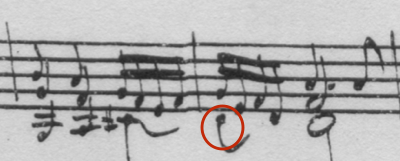
Busoni lowers the accompaniment an octave and adds a fifth (note that the upper stave is in bass clef):
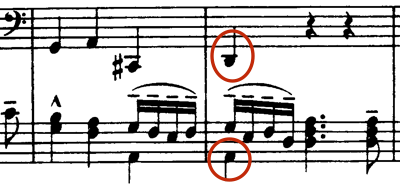
Segovia does the same thing and with the same voicing:
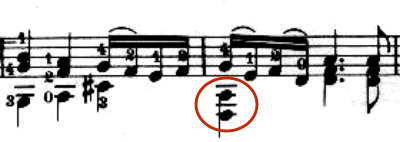
Example 2:
In measure 29 (and elsewhere), Busoni creates a bass pedal derived from the rhythm of the opening bars:
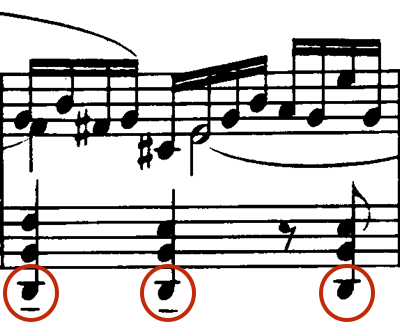
Segovia does the same, although he limits himself to one bass note because of the compressed range of the guitar:
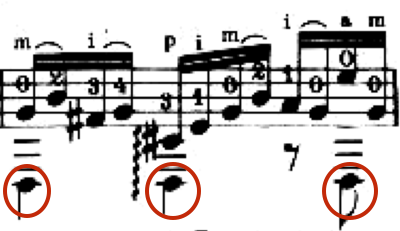
Example 3:
In measures 33–35 Bach presents the illusion of two voices from a single line, the harmonies for which are not explicit:
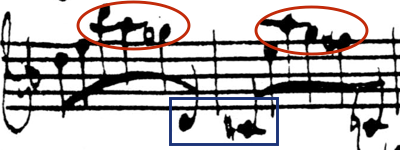
Busoni fills out the harmonies:
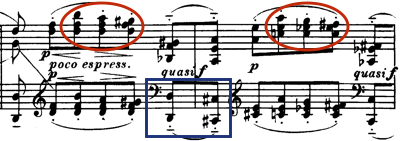
and Segovia follows suit with the same harmonies:
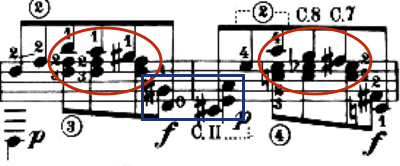
Notice also that Segovia’s dynamic markings reflect Busoni’s.
Example 4:
Sometimes common errors can be evidence of links between scores. Bach writes an a4 pick-up to measure 137:

Busoni’s score has a misprint which has moved the a4 down a line to an f♯4, a not uncommon type of error in engraved music (note that the upper stave is in the bass clef):
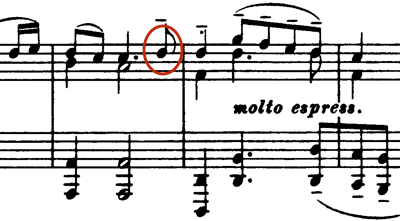
(Busoni has added five measures to the piece so the comparable bar in his score is m. 142.)
Segovia’s transcription has the same error:

It turns out that many early editions had the f♯4 misprint: Mendelssohn's version had it (but not Schumann’s) as did both the Raff and Pauer transcriptions. There must have been an early publication that had the misprint (perhaps the 1802 Simrock edition had it, but I've not seen it). So, this misprint by itself may not mean much. The Breitkopf und Härtel edition from 1879 had the correct note.
Example 5:
Finally, in measure 168 of Busoni’s score he picks up on a three-note motif introduced by Bach (in m. 163) in the upper voice,

and answers it in the bass (in octaves):
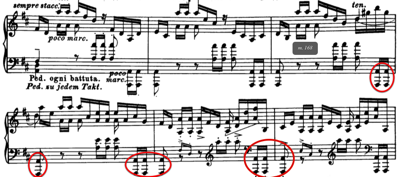
(This section starts earlier and I’ve not marked all instances of Busoni's additions.)
Busoni probably picked this up from Mendelssohn's 1847 version:

Nonetheless, Segovia once again follows Busoni's example, although without the octaves:

Chaconne à Son Goût?
Busoni certainly did things in his piano version that would not be possible or convincing on the guitar: larger chords, thicker textures, extended octave passages, and Segovia navigates those sections convincingly in his arrangement. I maintain, however, that there is more Busoni in the guitar arrangement than there is Segovia.
Whether Segovia was strongly influenced by Busoni, whether he worked directly from Busoni’s score, or whether he used both the violin score and Busoni’s arrangement matters little. (The latter is the most likely as Segovia did not include the five extra bars that Busoni added to the piece.) Almost all of Segovia’s added notes and harmonies were predicated on what Busoni did. And most of Segovia’s tempo and interpretive indications, while being only a fraction of what Busoni included, are either identical to Busoni’s or convey the same character.
Busoni’s transcription of Bach’s Chaconne is a masterpiece of Romantic performance style and there is much to be learned from studying it, either in the original piano score or through the filter of Segovia.
Give (the) Piece A Chance
I’m not suggesting guitarists emulate Segovia’s playing—I don’t think I’ve heard his recording of the piece since the 1970s—but the score is there, misunderstood in large part to the way Segovia presented it to the public in the 1930s, and it deserves a hearing.
It’s also gratifying to play. I’ll be performing it in Columbia, SC on January 31, 2016, at 3:00 p.m. in the Recital Hall of the School of Music at the University of South Carolina. If you’re in the area, drop by. The concert is free.
Another Note
For an interesting and intelligent conversation about the Bach Chaconne on the Watson Institute’s Open Source program between Christopher Lydon and violinist Arnold Steinhardt, listen to the January 1st, 2007 edition of the show and read the Open Source blog.
Richard Taruskin, Text and Act: Essays on Music and Performance, (New York: Oxford University Press, 1995) 302. ↩︎
This was before Wimsatt and Beardsley published their 1946 article, “The Intentional Fallacy,” in the Sewanee Review, which either reflected or engendered an outbreak of second thoughts for those who dealt with the interpretation of texts. ↩︎
Taruskin, 91. ↩︎
I love early music and stopped playing the guitar for over five years to devote myself exclusively to the study of the lute. I was not content to play the lute with a modified guitar technique and mastered what is known in the lute business as “thumb-under” technique. I’ve given scores of solo lute recitals as well as concerts with soprano/lutenist Hazel Ketchum, my partner in The Rossignol Duo. ↩︎
Taruskin, 167. ↩︎
Ibid., 72. ↩︎
Ibid., 170. ↩︎
Clive Brown, Classical and Romantic Performing Practice 1750-1900, (Oxford University Press, 1999) 4. ↩︎
Taruskin, 167–168. ↩︎
Ferruccio Busoni, Sketch of a New Esthetic of Music, (New York: Schirmer, 1911). ↩︎
Ibid., 15, 16. ↩︎
Taruskin, 167. ↩︎
Peter Kivy, Authenticities: Philosophical Reflections on Musical Performance, (Cornell University Press, 1998) 276. ↩︎
Carl Flesch, The Art Of Violin Playing, Book Two, (New York: Carl Fischer, Inc., 1930), 149. ↩︎
La Mara, (trans. Constance Bache), Letters of Franz Liszt, Vol. II, (London: H. Grevel & Co., 1894) 443. ↩︎
One might argue that he did add a comparable amount material in his "transcription" of the bourées from BWV 1009, which he recorded, but this arrangement was not his: it was by Tárrega. Tárrega's version, as well as recordings of it by both Barrios and Segovia, were issued under the erroneous title of "Loure." Why the title was never corrected in the recordings is beyond mysterious. ↩︎
Paul Banks, “Preface” to Bach-Busoni: Chaconne, (London: Edition Peters, 1997), 3. ↩︎
I don’t think guitarists are particularly larcenous, but at least one (Ständchen) of the six Schubert lieder “übertragen” by Johann Kaspar Mertz (1806–1856) was really an arrangement of Liszt’s piano arrangement. For information on the Sor-Coste-Segovia connection, see: Erik Stenstavold, “Coste’s Contribution to the Twenty Studies By Sor,” Soundboard, Vol. XI, No. 2, (1984): 136-140. ↩︎
Franz Liszt, The Schubert Song Transcriptions for Solo Piano/series III: The Complete Schwanengesang, Introduction by Alan Walker, (Dover Publications, 1999). ↩︎
